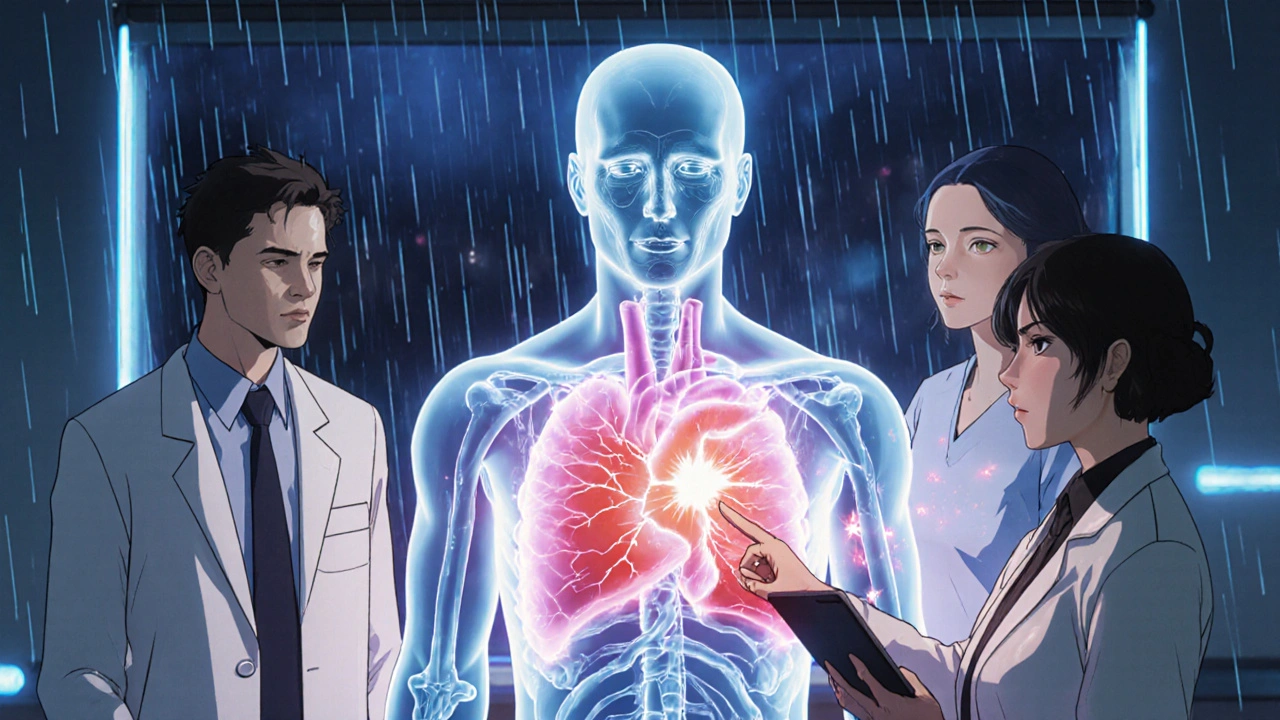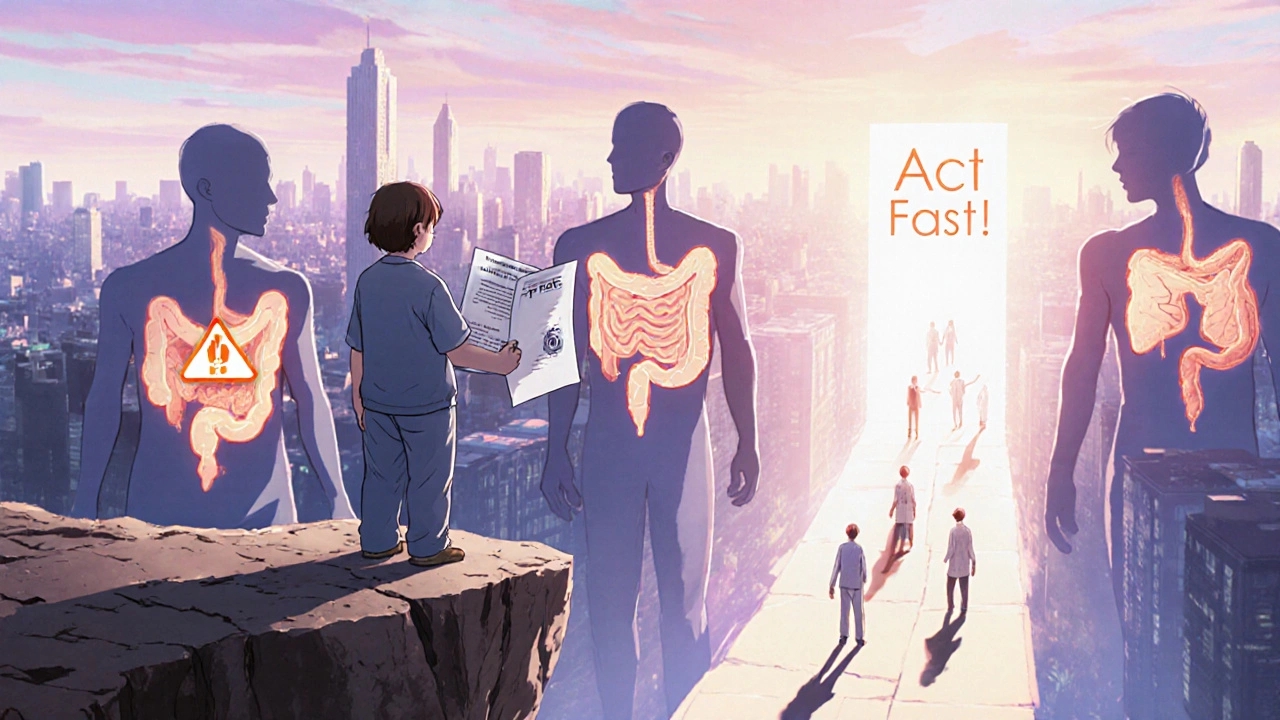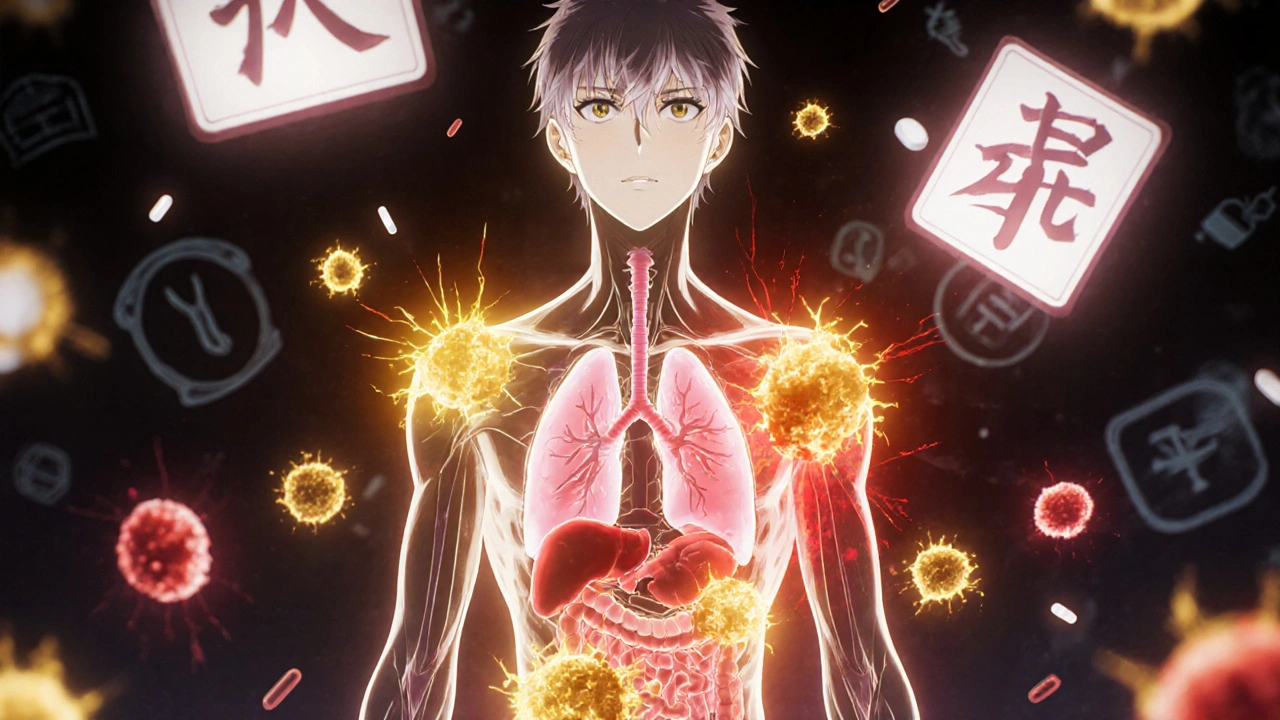When someone starts treatment with immune checkpoint inhibitors for cancer, the goal is simple: wake up the immune system to fight tumors. But sometimes, the immune system doesn’t stop at cancer. It turns on healthy tissues instead. These unintended attacks are called immune-related adverse events, or irAEs. They’re not rare. In fact, up to 83% of patients on certain immunotherapies experience them. And while many are mild, some can be life-threatening if missed or mishandled.
What Are irAEs and Why Do They Happen?
irAEs are side effects caused by immune checkpoint inhibitors (ICIs) - drugs like pembrolizumab, nivolumab, and ipilimumab. These drugs block signals that normally keep the immune system in check. Without those brakes, T-cells attack cancer cells more aggressively. But they can also attack the thyroid, colon, lungs, skin, liver, and even the heart. It’s like removing the safety lock on a gun - the target gets hit, but so does everything nearby.
Unlike chemotherapy side effects, which usually show up quickly and fade after treatment ends, irAEs can appear anytime. Most happen within the first three months, but some don’t show up until months after the last dose. That’s why patients need to stay alert long after finishing treatment.
Which Organs Are Most Affected?
Not all irAEs are the same. Some are common. Others are rare but deadly. The most frequent involve the gut, skin, and endocrine system.
- Gastrointestinal: Diarrhea and colitis are the most common. Patients may have more than six watery stools a day, abdominal cramps, or blood in stool. Grade 3 or higher colitis requires immediate action.
- Endocrine: The thyroid often gets hit - causing fatigue, weight changes, or heart palpitations. Hypophysitis (pituitary inflammation) can mess up cortisol and thyroid hormone production. These don’t respond to steroids the way other irAEs do. Instead, they need lifelong hormone replacement.
- Dermatologic: Rashes, itching, and blistering skin are common. Most are mild, but Stevens-Johnson syndrome - a severe skin reaction - can be fatal.
- Lungs: Pneumonitis causes cough, shortness of breath, and low oxygen. It’s one of the leading causes of death from irAEs.
- Heart: Myocarditis is rare (under 1% of cases) but carries a 2.7% fatality rate. Chest pain, irregular heartbeat, or sudden fatigue must be treated as an emergency.
- Nervous system: Nerve damage, muscle weakness, or confusion can signal neurotoxicity. These require neurologist involvement right away.
How Are irAEs Graded and Managed?
Doctors use the Common Terminology Criteria for Adverse Events (CTCAE) to rate severity. It’s simple:
- Grade 1: Mild symptoms. No treatment needed. Just monitor.
- Grade 2: Moderate. Symptoms interfere with daily life. Hold ICI treatment. Start oral steroids like prednisone (1 mg/kg per day).
- Grade 3: Severe. Hospitalization often needed. Switch to IV steroids (methylprednisolone, 1-2 mg/kg/day). Stop ICI permanently in many cases.
- Grade 4: Life-threatening. ICU-level care. High-dose steroids, plus second-line drugs like infliximab or IVIG.
For most Grade 2-3 irAEs, steroids are the first line. But here’s the catch: you can’t just stop them suddenly. Tapering over 4-6 weeks is critical. If you rush it, symptoms come back - sometimes worse. Patients often report feeling trapped by steroid side effects: weight gain, insomnia, mood swings. One study found 68% of patients said these side effects hurt their quality of life more than the original cancer symptoms.

What If Steroids Don’t Work?
About 20-30% of patients don’t respond to steroids. These are called steroid-refractory irAEs. When that happens, doctors turn to stronger immunosuppressants:
- Infliximab: Targets TNF-alpha. Used for colitis, pneumonitis, and some liver cases. Given as an IV infusion.
- Mycophenolate mofetil: Used for liver or kidney involvement.
- IVIG: Packed antibodies. Good for neurological or hematologic irAEs.
- Vedolizumab: Newer option. Blocks gut-specific immune cells. Shown to work better than infliximab in some colitis cases, with fewer side effects.
- Cyclophosphamide: Reserved for the toughest cases, like severe myocarditis.
Importantly, using these drugs doesn’t mean the cancer treatment is ruined. Multiple studies confirm that managing irAEs doesn’t reduce the chances of tumor control. The immune system can still fight cancer - even while being calmed down.
Why Timing Matters
Early detection saves lives. A 2023 analysis of over 12,500 patients showed that if treatment starts within 48 hours of symptom onset, hospitalization rates drop from 34% to 19%. That’s a huge difference.
But here’s the problem: patients often ignore early signs. A sore throat? Just a cold. Diarrhea? Maybe it’s the food. Fatigue? Of course they’re tired - they have cancer. Nurses report that 79% of patients don’t realize how urgent it is to call their oncologist about new symptoms. That delay can turn a mild rash into a life-threatening condition.
That’s why education is part of the treatment. Leading cancer centers now give patients printed guides, video tutorials, and 24/7 hotlines. The European Society for Medical Oncology is rolling out patient materials in 15 languages because language barriers are a real problem.
Who’s Involved in Care?
Managing irAEs isn’t just an oncologist’s job. It takes a team:
- Endocrinologists: For thyroid, adrenal, or pituitary issues.
- Gastroenterologists: For colitis or hepatitis.
- Pulmonologists: For lung inflammation.
- Neurologists: For nerve or muscle damage - absolutely essential.
- Dermatologists: For severe rashes or blistering.
- Oncology nurses: Often the first to notice changes. They’re the frontline.
Hospitals with dedicated immune toxicity teams - like MD Anderson - see 92% protocol adherence. Community clinics without those teams? Only 68%. That gap is why some patients die from delays.

What’s New in irAE Management?
The field is moving fast. In February 2024, the Society for Immunotherapy of Cancer updated its guidelines to include vedolizumab as a top choice for steroid-resistant colitis. Clinical trials are now comparing it directly to infliximab.
Scientists are also looking for biomarkers. A 2023 study found that patients with baseline IL-17 levels above 5.2 pg/mL had nearly five times the risk of severe irAEs. That could one day mean a simple blood test tells doctors who needs extra monitoring before starting treatment.
Electronic health records are catching up too. Epic Systems now has built-in alerts in its oncology module. If a patient reports new diarrhea or rash, the system flags it and auto-sends a referral to the right specialist - cutting hours off response time.
What Happens Long-Term?
Most irAEs resolve with treatment. About 85-90% of patients fully recover. But 10-15% end up with chronic issues. A damaged thyroid? Lifelong hormone pills. A destroyed adrenal gland? Daily steroid replacement. Some patients need ongoing immunosuppression for years.
And as more people get access to immunotherapy - now used in nearly half of all cancer patients in the U.S. - the number of people living with long-term irAEs is rising fast. Experts predict a 22% annual increase in specialized irAE clinics by 2028. These aren’t just side effects anymore. They’re a new kind of chronic disease.
Bottom Line: Know the Signs, Act Fast
irAEs are the price of a powerful therapy. But they don’t have to be a death sentence. The key is awareness - from patients, nurses, and doctors. If you’re on an immune checkpoint inhibitor, learn the warning signs. Don’t wait for them to get worse. Call your team the moment something feels off. Speed saves organs. Speed saves lives.
Can immune checkpoint inhibitors cause long-term side effects?
Yes. While most immune-related adverse events (irAEs) resolve with treatment, 10-15% of patients develop chronic conditions. These often involve endocrine organs like the thyroid or adrenal glands, requiring lifelong hormone replacement. Some patients also need ongoing immunosuppression for persistent inflammation in the gut, lungs, or liver. Regular follow-up with specialists is essential.
Do steroids make cancer treatment less effective?
No. Multiple studies, including large retrospective analyses published in the Journal of Clinical Oncology, show that using corticosteroids or other immunosuppressants to treat irAEs does not reduce the anti-tumor effect of immune checkpoint inhibitors. The immune system can still target cancer even while being controlled to protect healthy tissue.
What should I do if I develop diarrhea during immunotherapy?
Don’t wait. Contact your oncology team immediately. Diarrhea can be a sign of colitis, a serious irAE. If you have more than six stools a day, blood in stool, or abdominal pain, it’s likely Grade 2 or higher. You’ll need to stop immunotherapy and start steroids. Delaying treatment increases the risk of hospitalization or perforation. Rule out infections like C. diff first, but assume it’s an irAE until proven otherwise.
Are some irAEs more dangerous than others?
Yes. While most irAEs are mild, some carry high fatality rates. Myocarditis (heart inflammation) has a 2.7% death rate among affected patients. Neurological irAEs like encephalitis or Guillain-Barré syndrome can be fatal without rapid neurology involvement. Pneumonitis and hepatitis can also become life-threatening if not treated early. Always treat new symptoms as urgent until proven otherwise.
How do I know if my rash is an irAE or just a reaction to something else?
Any new rash during or after immunotherapy should be evaluated by your oncology team. irAE rashes are often widespread, itchy, and don’t respond to typical antihistamines or creams. They may appear as red patches, blisters, or peeling skin. If it’s spreading quickly, involves mucous membranes, or you have fever, it could be Stevens-Johnson syndrome - a medical emergency. Don’t assume it’s a drug allergy or sunburn. Get it checked.
Can I restart immunotherapy after an irAE?
It depends. For Grade 1 irAEs, treatment often resumes after symptoms resolve. For Grade 2, it may resume after steroid taper and full recovery. But for Grade 3 or 4, most guidelines recommend permanent discontinuation - especially for life-threatening events like myocarditis, encephalitis, or severe colitis. The risk of recurrence is too high. Your oncologist will weigh the cancer’s response against the potential for future toxicity.
Is there a blood test to predict irAEs before starting treatment?
Not yet for routine use, but research is advancing. A 2023 study in Nature Medicine found that patients with baseline serum IL-17 levels above 5.2 pg/mL had a 4.7-fold higher risk of developing severe irAEs. This biomarker is being tested in clinical trials and may soon help identify high-risk patients for closer monitoring before treatment begins.
What should I do if I can’t reach my oncologist right away?
If you have severe symptoms - chest pain, trouble breathing, confusion, or severe diarrhea with fever - go to the nearest emergency room. Tell them you’re on immune checkpoint inhibitors and suspect an irAE. Bring your treatment records if possible. Emergency departments at major cancer centers are trained to recognize these events. Don’t wait for a call back. Time is critical.


14 Responses
So let me get this straight - we’re basically unleashing a war criminal inside the body and calling it medicine? 🤯 I mean, if your immune system starts nuking your own organs, isn’t that just autoimmune terrorism with a fancy name? And don’t even get me started on steroids - now you’re trading cancer for moonface, insomnia, and a temper that makes your dog hide under the bed. This isn’t treatment. It’s a high-stakes game of Russian roulette with your biology.
This article is dangerously naive. The pharmaceutical industry doesn’t care if you live or die - they care about profit margins. They push these drugs because they’re expensive, and because they can sell you a whole new line of immunosuppressants to fix what the first drug broke. The real ‘irAE’ is the profit motive. Patients are guinea pigs in a corporate experiment dressed up as science.
One cannot help but contemplate the profound existential paradox inherent in modern oncological intervention: that the very mechanism designed to preserve life - the activation of immune vigilance - becomes the architect of its own undoing. The human body, a temple of intricate balance, is now the battlefield where salvation and self-destruction wear the same face. We have weaponized the immune system, and in doing so, have exposed the fragility of our biological covenant with ourselves.
Bro this is gold. I’m a med student in India and we barely learn this in class. The part about vedolizumab vs infliximab? Mind blown. Also, the 48-hour window thing? That’s HUGE. My uncle did immunotherapy and ignored his diarrhea for 5 days - ended up in ICU. If you feel weird after chemo, don’t wait. Call. Now. Even if it’s 2am. Your life depends on it.
To every patient reading this: You are not alone. The fatigue, the rashes, the fear - they are real, but they are not your enemy. Your body is fighting two battles at once, and you are the general. Trust your team. Speak up. Document your symptoms. You are stronger than you think. And yes - you can still beat cancer even if your thyroid needs help. You are not broken. You are adapting.
OMG YES THIS. 😭 I’m a nurse on an oncology floor and I see this EVERY DAY. Patients think ‘a little diarrhea’ is normal - until they’re in septic shock because no one caught the colitis early. We hand out these printed guides like gospel. One lady told me she printed it and taped it to her fridge next to the milk. I cried. Please, please, please - if you’re on immunotherapy, know your signs. You’re not overreacting. You’re saving your life. 🙏❤️
Speed saves lives. That’s not a slogan. It’s a fact backed by data. If you have new symptoms while on immunotherapy, treat them like a fire alarm - not a suggestion. Don’t wait for a ‘second opinion.’ Don’t Google it for three hours. Call your oncologist. If they’re not responsive, go to the ER. Say ‘immune checkpoint inhibitor’ and ‘suspected irAE.’ That’s all you need to say. Your life is worth more than your hesitation.
So let me get this straight - Big Pharma invented a drug that makes your immune system go full psycho, then sells you another drug to calm it down, then another to fix the side effects of the second drug? And you call this medicine? This isn’t healthcare. This is a pyramid scheme with IV drips. They don’t want you cured. They want you on maintenance forever. Wake up.
Isn’t it ironic that we’ve created a therapy that requires us to surrender our autonomy - to be medicated, monitored, and managed - in order to survive? We’ve turned healing into a bureaucratic ordeal. The body becomes a problem to be solved, not a miracle to be honored. What have we become, when we treat our own biology like a malfunctioning machine?
I lost my dad to myocarditis from nivolumab. It hit fast. No warning. They said ‘rare’ - but rare doesn’t mean impossible. He was 58. Fit. Never smoked. We thought he was getting better. Then he collapsed. No one told us about the chest pain signs. If I could go back - I’d have forced him to the ER the second he said his heart felt ‘off.’ This isn’t just info - it’s a lifeline. Share it. With everyone. Especially the quiet ones who don’t ask questions.
Thank you for writing this. I’ve been on pembrolizumab for 11 months. My thyroid’s toast. I’m on levothyroxine now. I used to feel guilty about needing meds just to function. But reading this - I realized: it’s not a failure. It’s adaptation. I’m still alive. I’m still here. And that’s worth more than any ‘perfect’ immune system.
As a caregiver for my mother who had severe pneumonitis - I can say this: the team approach works. We had oncology, pulmonology, and nursing all on the same page. The hospital had a dedicated irAE pathway. She’s in remission now. No steroids anymore. But she’ll need lung scans for life. Knowledge saved her. Don’t underestimate the power of asking ‘is this an irAE?’ - even if you feel silly.
Why is it always the patients who have to memorize the warning signs? Why aren’t the doctors trained to say: ‘If you feel ANYTHING unusual - even if it seems trivial - you must report it immediately’? Because if they did, they’d be overwhelmed. And if they’re overwhelmed, they can’t see 20 more patients today. The system is designed to ignore you until you’re nearly dead.
While the clinical data presented is compelling, one must consider the ethical implications of deploying therapies with such high potential for irreversible harm. The normalization of lifelong steroid dependence and organ replacement as ‘acceptable trade-offs’ raises profound questions regarding the boundaries of therapeutic intervention. Is survival at any cost truly the goal - or merely the default?